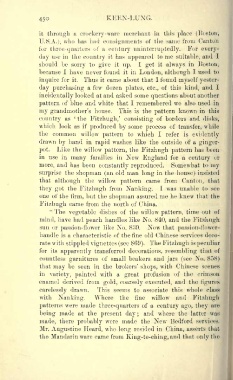Page 484 - Chinese Porcelain Vol II, Galland
P. 484
KEEN-LUNG.
450
it a -ware merchant in this place (Boston,
through crockery
U.S.A.), who has had consignments of the same from Canton
for of a For
three-quarters century uninterruptedly. every-
day use in the country it has appeared to me suitable, and I
should be to I
sorry give it up. get it always in Boston,
because I have never found it in London, although I used to
inquire for it. Thus it came about that I found myself yester-
a few dozen
day purchasing plates, etc., of this kind, and I
looked at and asked some about another
incidentally questions
pattern of blue and white that I remembered we also used in
my grandmother's house. This is the pattern known in this
country as ' the Fitzhugh,' consisting of borders and disks,
which look as if produced by some process of transfer, while
the common willow to which I refer
pattern is evidently
drawn by hand in rapid washes like the outside of a ginger-
Like the willow the has been
pot. pattern, Fitzhugh pattern
in use in many families in New England for a century or
more, and has been constantly reproduced. Somewhat to my
surprise the shopman (an old man long in the house) insisted
that the willow came from Canton, that
although pattern
they got the Fitzhugh from Nanking. I was unable to see
one of the firm, but the assured me he knew that the
shopman
Fitzhugh came from the north of China.
"
The dishes of the willow time out of
vegetable pattern,
mind, have had peach handles like No. 840, and the Fitzhugh
sun or like No. 839. Now that
passion-flower passion-flower-
handle is a characteristic of the fine old Chinese services deco-
rate with The
stippled vignettes (see 869). Fitzhugh is peculiar
for its that of
apparently transferred decorations, resembling
countless of small beakers and No. 858)
garnitures jars (see
that may be seen in the brokers' shops, with Chinese scenes
in with a of the crimson
variety, painted great profusion
enamel derived from gold, coarsely executed, and the figures
drawn. This seems to associate this whole class
carelessly
with Nanking. Where the fine willow and Fitzhugh
patterns were made three-quarters of a century ago, they are
being made at the present day ; and where the latter was
made, there probably were made the New Bedford services.
Mr. Augustine Heard, who long resided in China, asserts that
the Mandarin ware came from and that the
King-te-ching, only

